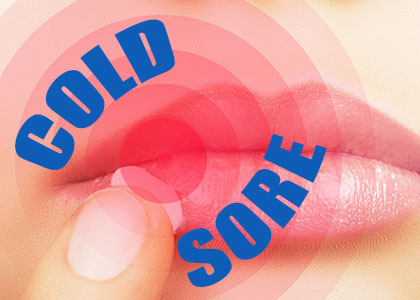Cold Sores 101
 Cold sore. Fever blister. Herpes simplex virus-1. These babies go by a lot of different names, but the experience is always the same:
Cold sore. Fever blister. Herpes simplex virus-1. These babies go by a lot of different names, but the experience is always the same:
- Tell-tale burning or itching near the lip
- Red bump appears a day or so later
- Bump becomes a cluster of blisters
- Blisters dry up and scab over
- The scab falls off
The whole process usually takes two weeks or less.
Infamous for irritating pain and ruining first dates everywhere, cold sores sure wreak a lot of havoc for something so small.
A cold sore is a symptom of the herpes simplex virus-1 (HSV-1) in your system. HSV-1 is so common that most people are exposed to it in childhood. Many people can have and spread the virus without ever actually having a cold sore.
Catching & Spreading a Cold Sore
Sadly, once you catch HSV-1, there is no permanent cure. Thankfully, it won’t do much harm. If you have HSV-1, you might occasionally experience cold sores with long periods between each outbreak. This is because HSV-1 has the habit of “sleeping” or being inactive for bouts of time before circumstances cause it to flare up.
If you get cold sores, anything that compromises your immune system will make you susceptible to an outbreak. This includes drinking too much alcohol, stress, lack of sleep[LINK], or being sick. Even overexposure to the sun can cause a cold sore flare.
HSV-1 is related to the same virus that causes the herpes STD: HSV-2. Both viruses can be passed via bodily fluids, but HSV-1 cold sores usually only appear around the mouth.
HSV-1 is extremely contagious and can be spread even without a visible cold sore. Washing hands and a large personal bubble are important to prevent spreading or catching cold sores. Don’t share cups, utensils, lip balm, or razors if you or someone you know has a cold sore.
Don’t worry about catching cold sores from the dentist. All rooms and equipment are thoroughly sanitized between each patient.
Cold Sores vs. Canker Sores
If you have a mouth sore, you might be wondering if it’s a cold sore or a canker sore (which is not contagious). There are two main ways you can tell the difference between the two: location and appearance.
Cold sores are mostly outside the mouth on the lips or nose, and canker sores are mostly inside the mouth. Cold sores are usually a group of red blisters. Canker sores are round, open sores with a yellow or gray center.
Cold sores might also cause fever, sore throat, and swollen lymph nodes.
Treating Cold Sores
Skin creams and gels can help ease the pain of cold sores and make them go away faster. Talk with your dentist and doctor if you want help fighting the effects of a cold sore. Long-term treatment may also help reduce the frequency and severity of your outbreaks.
Dr. Gauthier, your Pineville dentist is taking new patients and would love to help you love your smile! Make an appointment with us today if you have questions about cold sores or any other oral health issue.
http://www.webmd.com/skin-problems-and-treatments/tc/cold-sores-topic-overview#1

